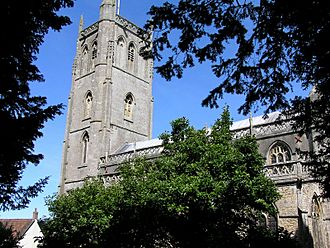St Andrew's Church, Banwell facts for kids
Quick facts for kids Church of St Andrew |
|
|---|---|
 |
|
| General information | |
| Town or city | Banwell |
| Country | England |
| Coordinates | 51°19′40″N 2°51′48″W / 51.3279°N 2.8633°W |
| Completed | 15th century |
The Church of St Andrew in Banwell, Somerset, England, is a very old and important church. Most of it was built in the 1400s. It is so special that it is called a Grade I listed building. This means it is one of the most important historic buildings in England.
Contents
Exploring the Church's Inside
The main part of the church, where people sit, is called the nave. It has high windows, known as a clerestory, which let in lots of light. On the sides of the nave are passages called aisles. The area near the altar, called the chancel, is a bit shorter than you might expect for a church this size.
Ancient Features and Art
Inside, you can find some amazing old pieces. The font, which is a large basin used for baptisms, is incredibly old. It dates all the way back to the 1100s! There is also a beautifully carved stone pulpit from the 1400s. This is where the priest stands to give sermons.
One very special item is the carved rood screen. This wooden screen was built in 1552. It separates the main part of the church from the chancel. It is remarkable because it survived a big historical event called the English Reformation. Many other church decorations were removed during that time.
The Tall Tower and Its Bells
The church has a tall tower that stands about 100 feet (30 meters) high. This tower was built around the year 1417. Inside the tower, there are ten bells. These bells were made at different times, from the 1700s to the 1900s. The church clock was added in 1884.
Special Carvings on the Tower
On the outside of the tower, facing west, you can see a special carving. It shows the Annunciation, which is a scene from the Bible. In this carving, the Virgin Mary has a lily pot next to her. A lily is a symbol of purity. You can also find lily leaf designs carved on the church's font and pulpit.
A Place of Remembrance
The churchyard, which is the area around the church, is also a place of history. It contains the war grave of a soldier from the Hampshire Regiment. This soldier fought in World War I, which ended over 100 years ago. It is a quiet spot to remember those who served.
See also
- List of Grade I listed buildings in North Somerset
- List of towers in Somerset
- List of ecclesiastical parishes in the Diocese of Bath and Wells

